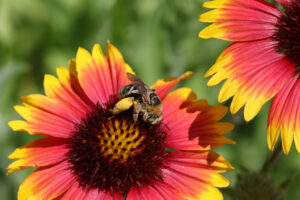Plant for Specialist Bees
Author: Lynn Richardson
Want to have an ecologically friendly yard? If so, encouraging pollinators must be on your to-do list!
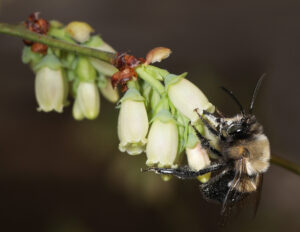 Blueberry digger bee on blueberry bush – a blueberry specialist.
Blueberry digger bee on blueberry bush – a blueberry specialist. Bees, our most important pollinator, are either generalists or specialists. Generalists, as the name implies, visit a variety of plants to gather pollen. Specialists, on the other hand, have evolved a relationship with one or only a few plant species, emerging from their nests at the same time their host plant(s) begin to flower. Roughly a third of our bees are specialists. Entomologist Doug Tallamy recommends landscaping your yard with plants that attract specialist bees, and these same plants will feed the generalists. This strategy makes for a healthy, diverse bee population.
Why should I care about pollinators?
One out of every three bites of food we eat is made possible by bees. They pollinate a third of our crops, making possible a greater variety of fruits and vegetables than would be available otherwise—no small contribution. But beyond that, they are a crucial component in the web of life. Pollinators and other insects sustain the earth’s ecosystems by sustaining the plants and animals that run those ecosystems. If pollinators disappear, nearly 90% of all earth’s plants and most other multicellular species, including humans, will disappear.
European colonists brought honey bees to North America. These non-native, domesticated bees are useful generalist pollinators that can be moved to where they are most needed. But they are in decline, and they can’t do all the work of pollination alone. Before importation of the honey bee, the nearly 4000 species of bees native to the United States provided pollination services. To keep our ecosystem healthy for the long haul, we must make our yards and neighborhoods bee friendly.
Why would I want to attract stinging insects to my yard?
Some facts may help allay your fears:
- Only female bees sting, and only in self-defense or in defense of the hive. Of the 4000 species of native bees, a mere 46 species have hives, which are tiny compared to honey bee hives. All other species are solitary and non-aggressive.
- Most bee stings occur when a honey bee is stepped on or is defending the hive. Bees visiting the flowering plants in your yard are intent on gathering pollen and nectar and have no interest in stinging you.
- Most stings attributed to bees actually come from yellow jackets, a type of wasp.
How can I attract our native bees to my yard?
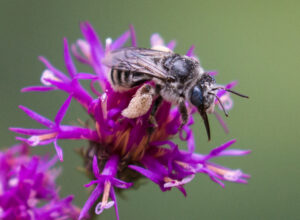 Eastern ironweed long-horned bee on ironweed.
Eastern ironweed long-horned bee on ironweed. Nest Sites: Our native bees nest in the ground, in wood or plant stems, or other nooks and crannies. Ground-nesting bees need bare, loose, dry soil, preferably with a slight slope to the south. Most soils except hard-packed clay are suitable. A couple of square feet of bare dirt can accommodate a good number of reproducing female bees. If you have or can create such a spot, be sure to avoid walking on it, which will compact the dirt and make it unusable. The bees will create tunnels several inches deep with side shafts, each containing a ball of pollen and a developing bee larva. How can you tell if the bees are nesting? Look for holes in the ground surrounded by small mounds of soil.
Some stem nesters prefer the stems of plants such as goldenrod, blackberries, and native hydrangeas that are essentially hollow except for a bit of pith that is easily removed. The bee constructs a series of cells within the stem, packs them with pollen, and lays an egg in each one.
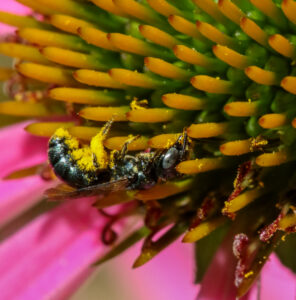 Mason bee, a stem & wood nester, on purple cone flower.
Mason bee, a stem & wood nester, on purple cone flower. If a larva matures late in the season, it will stay in its cell all winter, completing its development early the next spring. Don’t cut those dead stems down at the end of the growing season! You may be destroying the winter lair for bee larvae if you do. If leaving them is completely unacceptable for whatever reason, carefully and gently cut stems off near the ground, tie them together in a bundle, and stand them up for the winter somewhere out of public view where the bee larvae can complete their life cycle.
Other stem nesters prefer soft wood such as a fallen log or branch, a dead branch still attached to a tree, or a dead tree. Creating brush piles in your yard rather than removing debris and leaving dead trees standing that don’t pose a hazard to life or property will make bees (and many other creatures) happy.
Where possible, leave leaf litter under trees and in gardens and allow it to build up over time. These decaying leaves provide numerous ecosystem services, one of which is providing cover for overwintering queen bees.
Food: Adult bees eat nectar and pollen; larvae use only pollen. Since bees are active most months of the year, you’ll want to aim for plants to be flowering in your yard throughout all those months—roughly March through October.
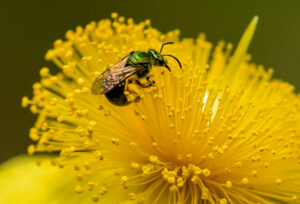 Metallic green sweat bee on St. Johns wort.
Metallic green sweat bee on St. Johns wort.Sweat bees nest in sloping soil and banks.
Much research is still needed on which plants support the most specialist bees, but we know that native plants (plants that evolved naturally over thousands of years in a particular region, not imported from other parts of the world) including perennial sunflowers (Helianthus species), goldenrods (Solidago species), asters (Symphotrichum species), and blueberries (Vaccinium species) are some of the best. The greater the variety of native flowering plants, the more bees your yard will support.
Avoid Pesticides: Many pesticides—even organic ones—are toxic to bees and other pollinators. Use nontoxic controls such as trapping and hand picking. If you must use pesticides as a last resort, choose targeted pesticides, such as Bt for caterpillars (keep in mind this kills butterfly larvae as well). Never apply insecticide immediately before or during bloom, since residues can stay active on plants and do harm days after application. If you notice pollinators visiting a plant, even one that is not in bloom, do not apply the product. The good news is that the more native pollinator plants your yard features, the more beneficial insects you’ll get, and beneficial insects are natural enemies of common pests.
A pollination refresher
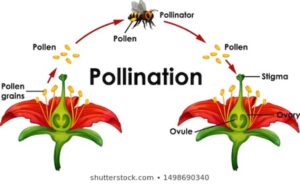
Flowers are the reproductive organ for about 90% of earth’s plants. The stamen, the male reproductive part of a flower, consists of a long slender stalk—the filament, with a two-lobed structure, the anther, at the tip, which produces pollen. Flowering plants reproduce by having pollen transferred from the anther to the female stigma, where fertilization takes place. Some plants contain both male and female parts on the same plant (self-pollinated); others have male parts on one plant and female plants on another (cross pollinated). After pollen reaches the stigma, a series of steps occurs, resulting in development of a seed, which contains the genetic information to produce a new plant.
World-wide, flowers rely on wind, water, and insects, birds, bats, and other animals that visit flowers to move pollen. Animals or insects that transfer pollen from plant to plant are called “pollinators.” Bees are by far our most important local pollinator.
Pollination is not intentional. As bees and other pollinators move from one flower to another, collecting pollen and nectar for nutrition, pollen falls onto the stigma and fertilization may take place.
Sources Consulted:
- Nature’s Best Hope by Douglas Tallamy. Portland, OR: Timber Press, 2019, pp. 155-168.
- US Forest Service, “What Is Pollination?”
- Xerces Society web site, “Wild Bee Conservation”
Photo credits:
- “Blueberry Digger Bee – Habropoda laboriosa on Highbush Blueberry, Leesylvania State Park, Woodbridge, Virginia” by Judy Gallagher, Creative Commons license – CC BY 2.0.
- “Diagram showing pollination with flower and bee illustration” – by Blue Ring Media, Shutterstock Royalty-free stock vector ID: 1498690340.
- All other bee photos by Barbara Driscoll.
